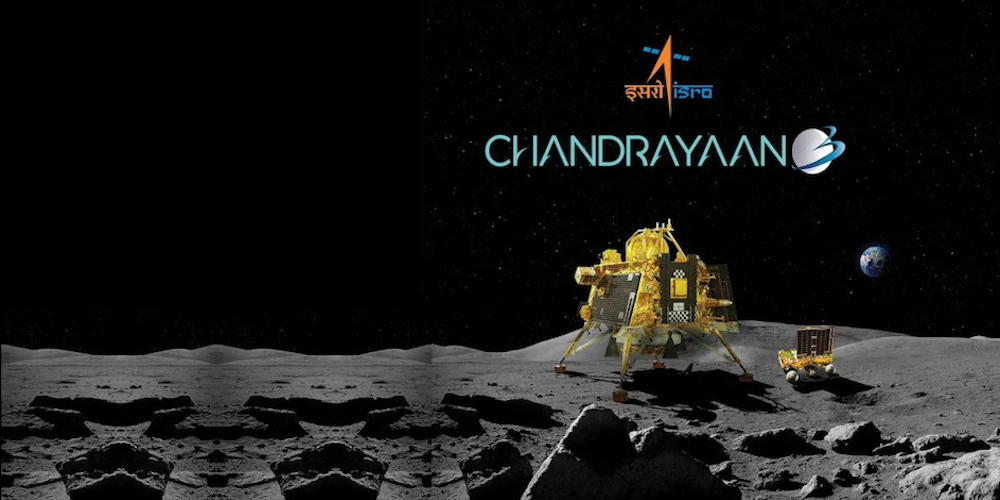India in Moon

After the successful landing of the Chandrayan III in Moon’s turbulent South Pole, the first by any spacecraft, on August 23, India has reaffirmed its position as a world’s frontline leading nation in the Space sector
As Dr Jitendra Singh, Minister o State for Science and Technology has rightly said, Prime Minister Narendra Modi ‘s leadership has enabled India’s Space scientists to vindicate the dream of their founding father Vikram Sarabhai by “unlocking” India’s Space sector and providing a milieu in which India’s huge potential and talent could find an outlet and prove itself to the rest of the world.
The successful soft landing on the surface of the Moon has India the fourth country in the world to achieve such a significant technological capability. The successful soft landing is envisaged to serve as fore-runners for future landing missions and other technological progress in planetary exploration.
The soft landing of Chandrayaan-2 was planned to be carried out in multiple phases. Certain unexpected variations in performances of the Lander Module eventually resulted in higher velocities at touchdown, which was beyond the designed capability of the Lander’s legs, resulting in a hard landing.
Chandrayaan-3 was made more robust by improvements in Lander to handle more dispersion, improvements in sensors, software and propulsion systems, full level redundancies in addition to exhaustive simulations and additional tests being conducted towards ensuring a higher degree of ruggedness in the lander.
Chandrayaan-3 in comparison to Chandrayaan-2 was designed with the capabilities to autonomously handle wide range of dispersion in order to achieve soft and safe landing.
The approved cost of Chandrayaan-3 is Rs. 250 Crores (Excluding Launch Vehicle Cost).
As regards the Chandrayaan-3, Vikram is the name of its lander. This name was chosen to honour late Vikram Sarabhai, the visionary behind India’s space endeavors. His legacy includes founding ISRO, elevating India to space exploration. His name symbolises progress.
Pragyan, the rover’s moniker, signifies wisdom. It operates post-landing, collecting data from five scientific instruments onboard the lander and rover. Both devices endure harsh lunar conditions, including chilling -238°C during nights.
In the next 14 days, the six-wheeled Pragyan lander and rover module of Chandrayaan-3 will provide data to the scientific community. After 14 days, there will be night on the moon for the next 14 days and since Vikram and Pragyan can only work in the sun, they will become inactive there. However, ISRO scientists have not ruled out the possibility of the duo coming back to life when the sun rises again.

The experiments onboard Vikram and Pragyan will be happening on all days and as much data will be collected from all instruments until the Moon’s Day lasts for the next 14 days.
The Lander’s instruments in operation include CHASTE (Chandra’s Surface Thermo-Physical Experiment) to carry out the measurements of thermal properties of the lunar surface near the polar region, LRA (Laser Retroreflector Array), RAMBHA-LP- a Langmuir Probe to measure surface plasma density, a laser reflector mounted on the corner of the Vikram for accurate positioning measurement of Lander on the Lunar surface by future orbiters, ILSA – Instrument for Lunar Seismic Activity to measure seismicity around the landing site and to understand the structure of the lunar crust and mantle, LIBS- Laser Induced Breakdown Spectroscopy to determine the elemental composition (Mg, Al, Si, K, Ca,Ti, Fe) of Lunar soil and rocks around the lunar landing site, APXS – Alpha Particle X-Ray Spectrometer to measure the chemical composition and mineralogical composition to further enhance our understanding of Lunar-surface and SHAPE – Spectro-polarimetry of HAbitable Planet Earth to study the spectro-polarimetric signatures of the habitable planet Earth in the near-infrared (NIR) wavelength range (1 – 1.7 μm).
According to Dr Jitendra Singh, at the end of next 14 days followed by night and extreme cold conditions when the day breaks again, solar power generation for Vikram and Pragayaan is expected to start again. Meanwhile, the orbiter is designed to withstand long periods of life, he said.
In sum, the objectives of Chandrayaan-3 were :
– Safe and Soft Landing
– Rover Roving on Moon Surface
– In-situ Scientific Experiments
It may be noted here that the Modi government has approved the Indian Space Policy – 2023 , which has been released in the public domain. The Policy opens up the sector for enhanced participation of Non-Government Entities (NGEs) across the entire value chain of the space economy, while clearly delineating the roles of various stakeholders viz. IN-SPACe, ISRO, NSIL and DOS.
Dr Jitendra Singh had informed the parliament recently that the Government has set up the Indian National Space Promotion and Authorization Centre (IN-SPACe) as a single-window agency for promotion and authorization of space activities. The budget allocations for IN-SPACe:
2021-22 Rs. 10 Cr
2022-23 Rs. 33 Cr
2023-24 Rs. 95 Cr
Similarly, the Laser Interferometer Gravitational Wave Observatory – India (LIGO-India) project has been approved by the Government of India at an estimated cost of Rs. 2600 Crore, with the Department of Atomic Energy as the Lead Agency. After completion of the project, LIGO-India will be operated as a national facility for detecting Gravitational Waves and Research in related areas of Astronomy.


